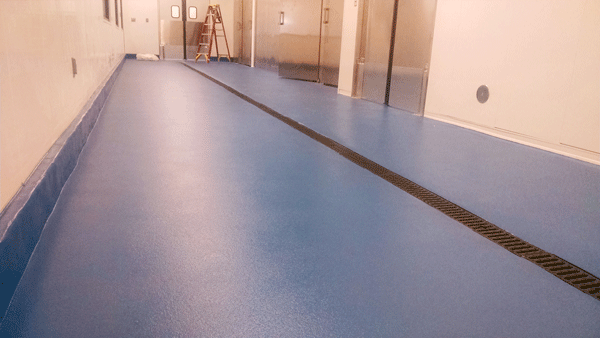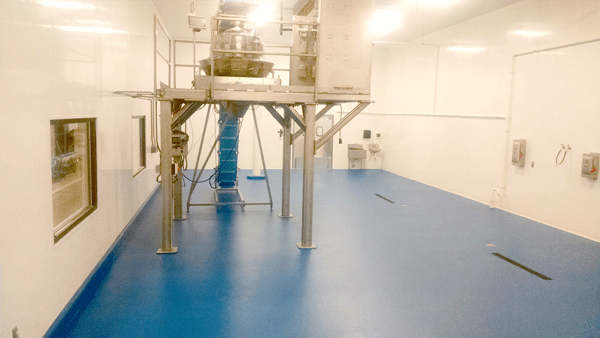Frankenmuth, Mich., nicknamed “Michigan’s Little Bavaria,” is home to German-style festivals, castle shops, and the world’s allegedly largest Christmas store. “For a place that’s not near the water, it’s a destination that’s land locked, it’s a very popular tourist town, it’s a great place for people to spend weekends,” Michigan Specialty Coatings, Inc.’s President Jonathan Winters said. “People are always looking for cool things to do.”
To compete in the touristy town, the owner of Michigan Brand, producer of jerkies and snack sticks, decided to operate a store across the street from the Christmas hub. The key is that not only will Michigan Brand offer meat products but that the owner will also be showcasing the back of the house to visitors with a tour.
“We wanted to put in a floor that was extremely durable,” Winters said. The floor needed to have high wear resistance, impact resistance, ultraviolet (UV) stability, and thermal shock resistance. It needed to counter pooling water and be nonporous. It was a tall order, and on top of all of that, “in a facility that’s surrounded by glass, it needs to look its best at all time,” Winters elaborated.
The solution: Over the course of five days, the five- to eight-person crew from Michigan Specialty Coatings worked to install a two-coat system by Tennant Company.
Meal Prep
The crew members got right to work on the project. They wore 3M full-face respirators with N95 filters, cut-resistant gloves, ear protection, steel-toed boots, and high-visibility shirts. For the surface prep, they wore full-face respirators both to protect their breathing and also to keep their vision clear. “The problem is that we find that when you wear a standard half-face respirator and then put safety goggles on, you fog your safety goggles up,” Winters explained. They used Hilti jackhammers with vacuums attached to protect people, too. Instead of hand grinders, this crew used hand scarifiers by Smith Manufacturing to prep around the edges of the room, the drains, and the terminations. That’s a bit unique for a floor contractor.
“The answer I often get is, ‘the edges don’t get a lot of traffic, so I can get away with a nominal profile,’ but that’s where I disagree,” Winters said. “I think customers are always washing equipment and the walls down, so you’re getting that potential for water and chemicals running down the wall searching for any breach or weak spot. I like to lock the edges down where a key cut is not required.”
It took eight crew members three days to prep the floors using Diamatic machines and the hand scarifiers. “You’re not going to get CSP [concrete surface profile] 6–8 with a hand grinder,” Winters said. “It is much slower, but it’s going to get a much better profile around the perimeter.” Any large debris created from the profiling was swept up and the walls were wiped down, and then the crew went back over the floor with a “very thorough slow vacuuming,” he said.
Unique Recipe
Although Michigan Specialty Coatings has done many floors for food or beverage facilities, this floor was unique. First, because of the color. “For every 70 red or gray floors that we do for food production, we’ll do one blue floor. When we’re talking about colors, it’s a cool look. When you have all your stainless equipment and bright white walls, that blue is different,” Winters explained.

Then, it was the thickness of the system. “What I’ve found is as people continue to put these coatings down thinner, the performance is so drastically reduced. We try to push the opposite…” Winters said. Instead of the average 1/4-inch (6.4 mm) thickness, they were sure to put it down at 3/8" (9.5 cm) by raking and troweling. “We are raking it out but it’s got a lot of body to it, so you hand trowel all the edges,” Winters said. And then they backrolled it “to bring a little of the resin to the surface.”
The anti-slip strategy may be seen as unusual, too. The crew broadcast the 54 grit aluminum oxide to rejection twice into the system: once broadcast into the Tennant Eco-Crete SF and again pre-mixed into Eco HTS. This was to help not only protect workers from slips but also to protect the coating from wearing.
“People will say that is absolute overkill and to them I say ‘good’ because…once this guy moves all of his stuff into the room, he’s going to have big, hard-wired, heavy, awkward equipment,” Winters said. And even though the thicker system with the double anti-slip was more expensive, in his words: “I want to do this right and I want to do it once.”
Onto the cementitious Eco-Crete SF layer with the broadcast went down, the crew applied the Eco HTS at 10–12 mils (254.0–304.8 microns). They used a dip and roll technique (as opposed to a squeegee) to get the right coverage over the peaks and valleys. The crew also used tape on the walls to mark how much surface each 1-gallon-square (3.8 L) kit should cover. That helped them with quality control, since wet film thickness gages wouldn’t have worked well with the anti-slip material.
Proof Is in the Jerky
The project covered 7,500 square feet (696.8 m²) of concrete in total throughout seven different rooms. “You have lots of drains, you have lots of terminations where you’re going in and out of other rooms, and/or where you’re butting up to stationary equipment that was installed prior to us coming to work,” Winters said. As he succinctly put it, “In this project, there’s a lot of edge detail.” But Winters and his crew came through. They gave the client a showpiece ready for tours and production that might even rival that famous Christmas store.
